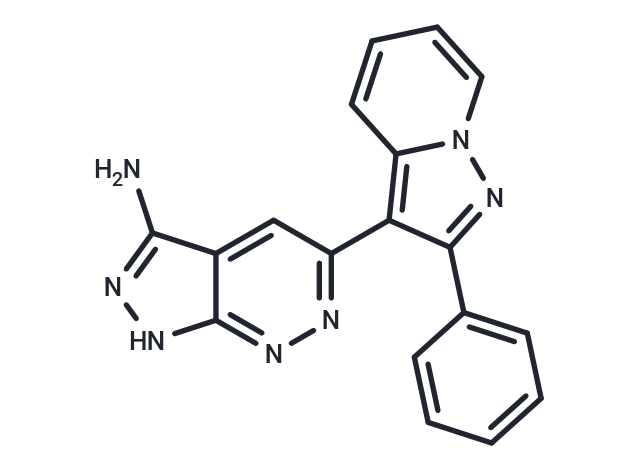Shopping Cart
- Remove All
 Your shopping cart is currently empty
Your shopping cart is currently empty

FR 180204 is a potent and selective ATP-competitive inhibitor of ERK1 and ERK2.

| Pack Size | Price | Availability | Quantity |
|---|---|---|---|
| 1 mg | $36 | In Stock | |
| 2 mg | $50 | In Stock | |
| 5 mg | $78 | In Stock | |
| 10 mg | $140 | In Stock | |
| 25 mg | $233 | In Stock | |
| 50 mg | $349 | In Stock | |
| 100 mg | $523 | In Stock | |
| 1 mL x 10 mM (in DMSO) | $86 | In Stock |
| Description | FR 180204 is a potent and selective ATP-competitive inhibitor of ERK1 and ERK2. |
| Targets&IC50 | ERK1:0.31 μM(Ki), ERK2:0.14 μM(Ki) |
| In vitro | In a mouse model of Dengue virus (DENV) infection, FR180204 was observed to restrict hepatocyte apoptosis, reduce DENV-induced liver damage, and enhance clinical parameters. Additionally, in mice with collagen-induced arthritis, FR180204 (100 mg/kg, i.p., b.i.d.) significantly mitigated the severity of symptoms and weight loss. |
| In vivo | FR 180204 inhibits the spontaneous growth of mesothelioma cells. In AP-1 transfected cells, FR180204 dose-dependently suppresses AP-1 transactivation, with an IC50 of 3.1 μM. |
| Kinase Assay | ERK assay: Nunc-Immuno MaxiSorp plates are coated with 20 μg/ml MBP solution in phosphate-buffered saline (PBS). After washing with PBS containing 0.05% Tween 20 (T-PBS), blocking buffer (T-PBS containing 3% BSA) is added to each well and the plates are incubated for 10 min at room temperature. After washing with T-PBS, chemical compounds, ATP and recombinant ERK2 diluted in assay dilution buffer (20 mM Mops, pH 7.2, 25 mM β-glycerol phosphate, 5 mM EGTA, 1 mM sodium orthovanadate, 1 mM dithiothreitol, and 50 μg/ml BSA) and are added to each well. Vehicle groups (containing 0.1% DMSO) and kinase-withdrawal groups are used for the control and basal determinations. After incubation for 1 h at room temperature, plates are washed twice with T-PBS. Anti-phospho MBP antibody (0.2 μg/ml) is added to each well, and the plates are incubated for 1 h at room temperature. After washing, anti-mouse HRP-conjugated polyclonal antibodies are added and the plates were incubated for 30 min. SuperSignal chemiluminescent substrate is used for the measurement of HRP activity according to the manufacturer's instructions. Prism 4.0 software is used for the Lineweaver–Burk plot analysis, IC50 and Ki determinations. |
| Cell Research | Cell viability is assayed by the method using MTT. MTT-reactive cells are quantified at an absorbance of 570 nm using a micro-plate reader. (Only for Reference) |
| Alias | FR180204 |
| Molecular Weight | 327.34 |
| Formula | C18H13N7 |
| Cas No. | 865362-74-9 |
| Smiles | NC=1C2=CC(C=3C(=NN4C3C=CC=C4)C5=CC=CC=C5)=NN=C2NN1 |
| Relative Density. | 1.55 g/cm3 (Predicted) |
| Storage | Powder: -20°C for 3 years | In solvent: -80°C for 1 year | Shipping with blue ice. | ||||||||||||||||||||||||||||||
| Solubility Information | DMSO: 32.7 mg/mL (99.9 mM), Sonication is recommended. | ||||||||||||||||||||||||||||||
Solution Preparation Table | |||||||||||||||||||||||||||||||
DMSO
| |||||||||||||||||||||||||||||||

Copyright © 2015-2025 TargetMol Chemicals Inc. All Rights Reserved.